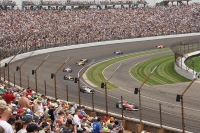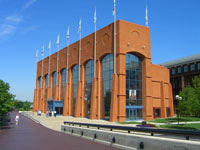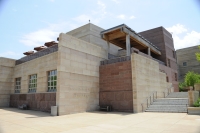City guides


Indianapolis Travel Guide
As far as Midwest travel destinations go, the capital of Indiana state may not shine as much as Chicago or St Louis. However, tourists who visit Indianapolis will find multiple attractions that are easily accessible, including the Indianapolis Motor Speedway, which many consider to be hallowed ground. The location's history of hosting races spans more than a century and, today, it welcomes racing devotees by the thousands for the Indy 500. During the winter, Indianapolis is a hotspot for football fans, whose fervour for the Colts has reached frenzied heights since the team won Super Bowl XLI.
The city also offers a lot for travellers who are less enthusiastic about spectator sports. Once dubbed 'Indiana No Place' by former first lady, secretary of state and US presidential candidate, Hillary Clinton, Indianapolis is now a well-rounded destination that caters for a variety of other interests, with history featuring strongly among them. At the centre of town is Monument Circle, which is home to the 284-foot (87m) Soldiers and Sailors Monument, among many others. From the circle, the city spreads outward in a grid and is divided into six cultural districts. Broad Ripple Village mixes sidewalk cafes and upscale boutiques with retro fashions and original music venues. Fountain Square is a funky downtown neighbourhood laid out like a European village. Both are known for their artistic leanings and abundance of ethnic restaurants. Indiana Avenue showcases the city's African-American heritage, and Mass Ave is the free-spirited, friendly arts and theatre district.
The final two cultural districts may have less of an eclectic vibe, but they are packed with attractions. Travellers in search of good, old-fashioned American consumerism need look no further than the Wholesale District's Circle Centre, a large shopping mall connected to the Indiana Convention Center and a number of downtown hotels via skywalks. Wholesale is the home of the business district as well as Bankers Life Fieldhouse, where the Indiana Pacers play, the Colts' RCA Dome and loads of chain restaurants. For visitors who wish to spend a bit of time enjoying the fresh air, there's the Canal and White River Park district. The Canal Walk snakes through the city, offering an urban respite for fitness buffs, while scattered throughout the 250-acre state park are top museums, unique festival and concert spaces and the Indianapolis Zoo.
Things to do in Indianapolis
Indianapolis is a major Midwestern metropolis, with no end of attractions for curious visitors. A walking tour of the city includes major landmarks such as the Indiana State Capitol building, the Soldiers and Sailors Monument, the Indiana War Memorial, and the Scottish Rite Cathedral.
On pleasant days, Indianapolis has a number of parks and gardens to enjoy, including the White River Gardens, Garfield Park Conservatory, the Oldfields-Lilly Estate, and of course the Indianapolis Zoo.
There are plenty of cultural attractions in Indianapolis, as the city boasts more than a dozen excellent museums. Families will want to visit the Holbomb Observatory and Planetarium and the Children's Museum of Indianapolis; while history buffs can enjoy the Conner Prairie Living History Museum, the Indiana State Museum, the Eiteljorg Museum of American Indians and Western Art, and The Benjamin Harrison Presidential Site.
The city also offers a number of art galleries and performing arts venues, and is home to fun summer events such as the Indiana State Fair, Bands of America Grand Nationals, and the Indy Fringe Festival.

Indianapolis Motor Speedway
The Indianapolis 500 takes place each May, but the iconic Speedway remains an exciting attraction all year round. In addition to hosting other racing events, including motorcycle racing, it's the home of the Indianapolis Motor Speedway Hall of Fame Museum, which has a huge collection of memorabilia and racing, classic and antique cars, as well as Brickyard Crossing, a Pete Dye-designed golf course with four holes inside the raceway oval. Visitors can explore the museum, or join a tour of the entire grounds. Buses offer the chance to take a lap on the track, and the Indy Racing Experience allows people to experience the track as a passenger in a real Indy racing car.

NCAA Hall of Champions
Americans follow university athletics with as much passion as they do professional sports. The Hall of Champions' 25,000-square-feet of exhibit space captures the traditions, historic moments, student athletes, and coaches of the 23 sports administered by the National Collegiate Athletic Association and 88 national championships. The museum has two levels of exhibits and offers interactive areas for visitors to compete both digitally and hands-on. It even has a 1930s retro basketball gymnasium. The Campus Corner gift shop offers all the NCAA logo merchandise a college sports fan could imagine. Though perhaps not an exciting attraction for the uninitiated, fans of American college sport will be enthralled by the NCAA Hall of Champions.

Eiteljorg Museum of American Indians and Western Art
The only museum of its kind in the Midwest, the Eiteljorg Museum contains one of the best Native American and Western art collections in the world. Designed to encourage appreciation and understanding of the cultures of the indigenous peoples of North America, the museum showcases work by contemporary artists such as N.C. Wyeth and Georgia O'Keeffe. It also displays art and artefacts including pottery, woodcarvings and apparel of the Delaware, Miami, Potawatomi and many other Native American cultures. A great attraction for families visiting Indianapolis, the museum has a number of interactive exhibits children will love, including a stagecoach, totem pole and wigwam. In addition, a number of events are hosted throughout the year, including storytelling on Saturdays, outdoor markets and concerts, and social dances.
Getting Around
Indianapolis' multitude of major highways makes the self-drive option quite convenient. Traffic congestion, however, can be a problem. Public transportation is provided by IndyGo. The red and green lines service downtown attractions, hotels and restaurants, as well as shopping and nightlife spots. Rideshare services include Uber and Lyft.
Indianapolis Climate and Weather
Indianapolis has a humid subtropical climate and experiences hot, humid summers (June to August) with average temperatures ranging from 64ºF (18ºC) to 89ºF (32ºC). Winters are cold, dipping down to 24ºF (-4ºC) in January, and occasionally getting as cold as -15ºF (-26ºC), although this is rare. Snowfall is unpredictable; while some years receive almost no snow, occasional blizzards can bring as much as 19 inches (48cm) in a 24-hour period. Spring is the wettest time of year, with May receiving up to 12.5 inches (32cm) of rain. The best time of year to visit Indianapolis is late summer and early autumn (August to October).
United States of America travel info
Electricity
The electrical current is 120 volts, 60Hz. Plugs are mainly the type with two flat pins, though three-pin plugs (two flat parallel pins and a rounded pin) are also widely used. European appliances without dual-voltage capabilities will require an adapter.
Language
English is the most common language spoken but Spanish is often heard in the south-western states.
Money
The official currency is the US Dollar (USD), which is divided into 100 cents. Only major banks exchange foreign currency. ATMs are widespread and credit cards are widely accepted; Apple Pay and Google Pay are very popular. Banking hours are Monday to Friday 9am to 3pm.
Tipping
A 15 percent tip is expected by taxi drivers, bartenders, hairdressers and waiters, but travellers shouldn't tip in fast-food or self-service restaurants. In expensive restaurants or for large parties, the tip should be 20 percent of the bill. It's normal to tip staff such as valets and porters in hotels; this is discretionary, although a minimum of $5 is expected. Most services are customarily tipped if the service is good.
Health
There are no specific health risks associated with travel within the USA. Medical facilities are excellent, but expensive. Only emergencies are treated without prior payment and treatment can be refused without evidence of insurance or proof of funds. Good medical insurance is essential.
Safety
Travel within the United States is generally trouble-free, though travellers should be aware that the US shares with the rest of the world an increased threat from terrorist incidents. Security has been heightened, particularly at airports. Restrictions on hand luggage apply and travellers are advised to check on the latest situation with airlines in advance. Travellers should also be alert to the dangers of car and street crime in cities and should use common sense and take basic precautions. Hurricanes are common between June and November, putting the southern USA, including the Gulf Coast and the eastern US at risk. There's a risk of wildfires in many dry areas in the US, particularly on the West Coast from March to November.
Local customs
Laws vary from state to state, including speed limit, fines and punishment. The age at which alcohol may be legally bought and consumed is 21 years.
Doing business
In such a large country, filled with so many diverse groups, business practices may differ according to each state, though rarely to any large degree. The East Coast is traditionally more formal than the West Coast, though in states such as California, dress code and conservative appearance are as common as they would be in New York. Punctuality is important throughout the country and it's considered rude to be late for a meeting. Gift-giving is uncommon as it may be construed as bribery. Appropriate titles (Mr, Mrs, Ms) are used upon introduction and until otherwise stated. Americans favour politeness and greetings of 'Hello' and 'How are you?' are often expressed with sincerity. Business hours may vary in each state, but an 8am start and 5pm finish Monday to Friday is the most common with an hour over lunch.
Status and age are not necessarily indicative of seniority, nor do they carry much weight in themselves. Those doing business in the States should be mindful of this fact; foreigners should never make assumptions about someone's position or rank. Best practice is to be respectful to all parties. That said, the US upholds a hierarchal business structure in which 'the boss' is the ultimate decision-maker. Senior leaders have the power of the last word, and can go against the grain just as easily as they can follow popular opinion. Foreigners should concentrate on winning over this individual, even if the greater group seems unsupportive. Americans value a direct style of communication. In this fast-paced, consumer culture 'time is money', and small-talk is viewed as unnecessary and wasteful. It's best for foreigners to get to the point quickly, speak about issues in a frank and open manner, and to avoid taking offence if someone questions or challenges them outright.
Duty free
Travellers to the United States who are returning residents of the country do not have to pay duty on articles purchased abroad to the value of $800 provided their stay was longer than 48 hours and their duty-free allowance was not used in the 30-day period prior. For passengers arriving from Samoa, Guam and the U.S. Virgin Islands, a duty-free allowance of $1,600 is allowed. The following items are included in this: 50 cigarettes and 10 cigars and 150 millilitres (5 fl. oz.) of alcoholic beverages or 150 millilitres (5 fl. oz.) of perfume containing alcohol. Restrictions may apply to goods from Cuba, Iran, North Korea, Burma (Myanmar), Angola, Liberia and Sudan. It is prohibited to import Cuban cigars from any country.
Travellers to the United States who are non-residents do not have to pay duty on the following items: 50 cigars or 200 cigarettes and gifts to the value of $100 provided their stay in the USA is not less than 72 hours and that the allowance has not been used in the preceding six-month period.
Prohibited items for residents and non-residents include meat or meat products, poultry, narcotics, absinthe, plants, seeds, vegetables, fruits, soil, live insects and other living plants or animal pests. Fish is prohibited unless it carries disease-free certification. Wildlife and animals or their by-products carry restrictions. Dairy products and eggs from specified countries are not allowed. Firearms and ammunition are not allowed without the necessary license and permit.
Communications
The international country dialling code for the United States is +1. Mobile networks cover most of the country, especially all urban areas; travellers can purchase local prepaid SIM cards for unlocked phones or use eSIMs if their cellular providers support it on their networks. WiFi is widely available.
Passport & Visa
It is highly recommended that travellers' passports have at least six months' validity remaining after the intended date of departure from them travel destination. A visa is required for short visits unless travellers qualify for entry under the Visa Waiver Program.
The Visa Waiver Program (VWP) enables citizens of certain countries to travel to the US for a stay of up to 90 days without a visa. Visitors under the VWP need a valid Electronic System for Travel Authorization (ESTA), which allows the US government to screen all visitors before travel. Visitors entering the country under the VWP must have a machine-readable passport (MRP) that has a barcode on the photo page. Travellers under the VWP must have passports that include biometrics if they wish to enter the country without a visa, which means that passports must contain unique personal data such as fingerprints or iris details. All passports must contain a digital photo image in order to travel visa-free. All visitors to the USA have a photograph and two fingerprints taken by an inkless scanner on arrival, including those travelling visa-free under the VWP.
As part of the Western Hemisphere Travel Initiative (WHTI), all travellers travelling between the United States and Canada, Mexico, Bermuda, and the Caribbean region are required to present a passport or other valid travel document to enter or re-enter the United States. If departing from the USA, a valid passport is required by immigration authorities. Immigration officials often apply different rules to those stated by travel agents and official sources.
Entry requirements
US citizens require passports.
UK nationals require a passport valid for duration of stay. Most passport holders can get an Electronic System for Travel Authorisation (ESTA) through the Visa Waiver Programme, which allows travel to the US for up to 90 days. The VWP includes tourism, certain types of business visit and transit to another country.
The most important requirement on entering the U.S. is providing proof of Canadian citizenship. A valid Canadian passport is the best document to prove Canadian citizenship and the right to return to Canada. However, several other documents can serve, depending on the mode of transport. Generally, Canadian citizens do not require visitor, business, transit or other visas to enter the United States from Canada, though there are some exceptions.
Passports must be valid for the period of intended stay. If visiting the US for fewer than 90 days, Australian nationals may be eligible to apply for an Electronic System for Travel Authorization (ESTA), and enter under the Visa Waiver Program (VWP).
South Africans must hold a passport valid for duration of stay. A visa is required.
Passports must be valid for duration of stay. Irish nationals can get an Electronic System for Travel Authorisation (ESTA) under the Visa Waiver Programme for entry into the United States.
Passports must be valid for duration of stay. New Zealand nationals can get an Electronic System for Travel Authorisation (ESTA) under the Visa Waiver Programme for entry into the United States.
Useful contacts
United States Tourist Office: www.usatourist.com
911 (General)Embassies / consulates in other countries
United States Embassy, London, United Kingdom: +44 20 7499 9000.
United States Embassy, Ottawa, Canada: +1 613 688 5335.
United States Embassy, Canberra, Australia: +61 2 6214 5600.
United States Embassy, Pretoria, South Africa: +27 12 431 4000.
United States Embassy, Dublin, Ireland: +353 1 668 8777.
United States Embassy, Wellington, New Zealand: +64 4 462 6000.
Embassies / consulates in United States of America
British Embassy, Washington DC: +1 202 588 6500.
Canadian Embassy, Washington DC: +1 202 682 1740.
Australian Embassy, Washington DC: +1 202 797 3000.
South African Embassy, Washington DC: +1 202 232 4400.
Irish Embassy, Washington DC: +1 202 462 3939.
New Zealand Embassy, Washington DC: +1 202 328 4800.


